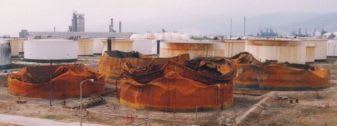in a storage tank farm, a bund wall is existent around each storage tank and the distance between tanks is big and enough that mak the radiation from any tank pool fire to the nearest tank is less than 10 kw/m2 , and the storage tank capacity around 10000 BBl crude oil,
Is it mandatory to install a fixed cooling/deluge system around each tank?
Is it mandatory to install a fixed cooling/deluge system around each tank?

